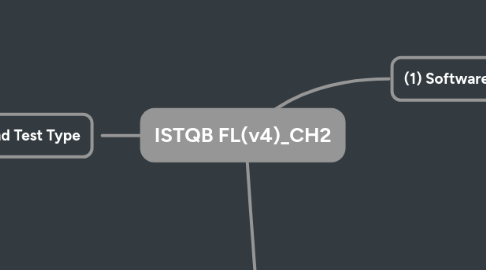
1. (2) Test Levels and Test Type
1.1. Test Levels
1.1.1. Component
1.1.1.1. Testing components in isolation (by dev)
1.1.2. Component integration
1.1.2.1. Testing the interfaces and interactions between components (by dev)
1.1.2.1.1. bottom-up
1.1.2.1.2. top-down
1.1.2.1.3. big-bang
1.1.3. System
1.1.3.1. overall behavior of the entire system
1.1.3.1.1. functional testing
1.1.3.1.2. non-functional testing
1.1.4. System integration
1.1.4.1. Testing the interfaces of the system with other systems
1.1.4.1.1. test environments should be similar to the operational environment
1.1.5. Acceptance
1.1.5.1. focuses on validation
1.1.5.1.1. User acceptance testing (UAT)
1.1.5.1.2. operational acceptance testing
1.1.5.1.3. contractual and regulatory acceptance testing
1.1.5.1.4. alpha and beta testing
1.2. Test Types
1.2.1. Functional
1.2.1.1. “what” the test object should do
1.2.2. Non-functional
1.2.2.1. testing of “how well the system behaves”
1.2.2.1.1. Performance
1.2.2.1.2. Compatibility
1.2.2.1.3. Usability
1.2.2.1.4. Reliability
1.2.2.1.5. Security
1.2.2.1.6. Maintainability
1.2.2.1.7. Portability
1.2.3. Black-box
1.2.3.1. Checking the system's behavior against its specifications (specification-based)
1.2.4. White-box
1.2.4.1. cover the underlying structure by the tests (structure-based)
1.3. Confirmation Testing
1.3.1. confirms that an original defect has been successfully fixed Can be done by:
1.3.1.1. Executing all the failed test cases
1.3.1.2. Adding new tests to cover any change
1.3.1.3. Reproducing the failure and ensuring it no longer occurs
1.4. Regression Testing
1.4.1. confirms that a change or the confirmed fix has not resulted in adverse consequences
1.4.1.1. Perform an impact analysis to know which parts of the software could be affected
2. (1) Software Development Lifecycle
2.1. Models
2.1.1. Sequential
2.1.1.1. waterfall model
2.1.1.2. V-model
2.1.2. Iterative
2.1.2.1. spiral
2.1.2.2. prototyping
2.1.2.3. Kanban
2.1.2.4. Scrum
2.1.3. Incremental
2.1.3.1. Unified Process
2.2. Impact on Testing
2.2.1. Scope and timing
2.2.2. test documentation
2.2.3. test techniques and approach
2.2.4. test automation
2.2.5. Role and responsibilities
2.3. Testing practices
2.3.1. Every SD activity, has a corresponding test activity
2.3.2. Test levels have specific and different test objectives
2.3.3. Initiate test analysis and design during the corresponding development phase
2.3.4. Involve testers in reviewing workproducts
2.4. Testing as a Driver for SD
2.4.1. Test-Driven Development (TDD)
2.4.1.1. Directs the coding through test cases
2.4.2. Acceptance Test-Driven Development (ATDD)
2.4.2.1. Derives tests from acceptance criteria
2.4.3. Behavior-Driven Development (BDD)
2.4.3.1. Using the (Given/When/Then) format
2.5. DevOps
2.5.1. Development (including testing) and operations work together
2.5.1.1. Fast feedback
2.5.1.2. shift-left approach
2.5.1.3. Continuous integration (CI) continuous delivery (CD)
2.5.1.4. Build, test and release high-quality code faster
2.5.1.5. focus on non-functional quality
2.5.1.6. regression risk is minimized
2.6. Shift-Left Approach
2.6.1. Reviewing the specification
2.6.2. Writing test cases before the code
2.6.3. Using CI and CD --> fast feedback
2.6.4. static code analysis
2.6.5. non-functional testing at the component test level
2.7. Retrospectives
2.7.1. Discuss
2.7.1.1. What was successful, and should be retained?
2.7.1.2. What was not successful and could be improved?
2.7.1.3. How to incorporate the improvements ?
2.7.2. Benefits
2.7.2.1. Increased test effectiveness / efficiency
2.7.2.2. Increased quality of testware and test basis
2.7.2.3. Team bonding and learning
2.7.2.4. cooperation between development and testing
3. (3) Maintenance Testing
3.1. Scope depends on
3.1.1. The degree of risk of the change
3.1.2. The size of the existing system
3.1.3. The size of the change
3.2. Classified as
3.2.1. Modifications
3.2.1.1. Planned releases
3.2.1.2. Unplanned releases (hot fix)
3.2.2. Upgrades or migrations of the operational environment
3.2.3. Retirement
3.2.3.1. Testing of data archiving and restore procedures
